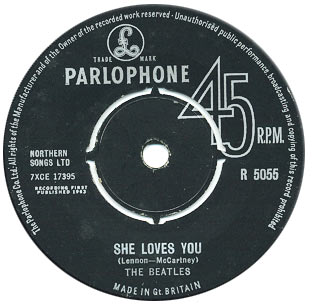| Notes and Quotes: "She Loves You" |
|
| Begun in Newcastle-upon-Tyne, on 26 June 1963. |
| Finished 27 June 1963 in the McCartney home. |
|
| McCartney: We must
have had a few hours before the show so we said, "Oh, great! Let's have
a ciggy and write a song!" So that's how we began "She Loves You." I remember
for some reason thinking of Bobby Rydell; he must have had a hit that
we were interested in. [Bobby Rydell's "Forget Him" was in the UK charts
at the time.] I remember thinking of him and sitting on the bed in this
hotel somewhere with John in the afternoon daylight. It was again a she,
you, me, I, personal preposition song. I suppose the most important thing
about it was that was a message song, it was someone bringing a message.
It wasn't us any more, it was moving off the "I love you, girl" or "love
me do," it was a third person, which was a shift away. "I saw her,
and she said to me, to tell you, that she loves you,"
so there's a little distance we managed to put in it which was quite interesting.
(Miles 1997: 149) |
| McCartney: We went
into the living room — "Dad, listen to this. What do you think?" So we
played it to my dad and he said, "That's very nice, son, but there's enough
of these Americanisms around. Couldn't you sing, "She loves you. Yes!
Yes! Yes!" At which point we collapsed in a heap and said, "No, Dad, you
don't quite get it!" That's my classic story about my dad. For a working-class
guy that was rather a middle-class thing to say, really. But he was like
that. (Miles 1997:150) |
| Geoff Emerick: Of
course, Norman Smith had a lot to do with the quality of the record, too.
clearly, he had been thinking about how he wanted to improve the sound
of Beatles records, and on this session he made two significant changes.
first, using an electronic device called a "compressor," he
decided to reduce the dynamic range—the difference between the loudest
and softest signals—of the bass and drums independently of each other;
in the past, they had been compressed together because they comprised
the rhythm section. Second, he specificed that a different type of microphone
be suspended over the drum kin—the "overhead" mic, as it was
known. The result was a more prominent, driving rhythm sound: both the
bass and the drums are brighter and more "present" than in previous
Beatles records. Combined with the group's new confidence and more intese
playing (fueled, I am sure, by the adrenaline and testosterone rush they
were feeling that afternoon), it was the icing on the cake. (Emerick 2006:
67) |
|
| Schedule |
|
7 February, 2012
|

